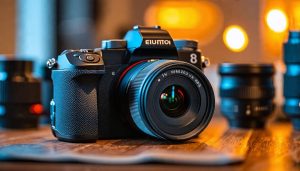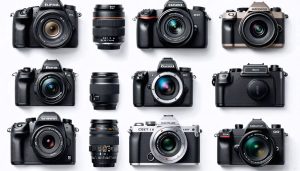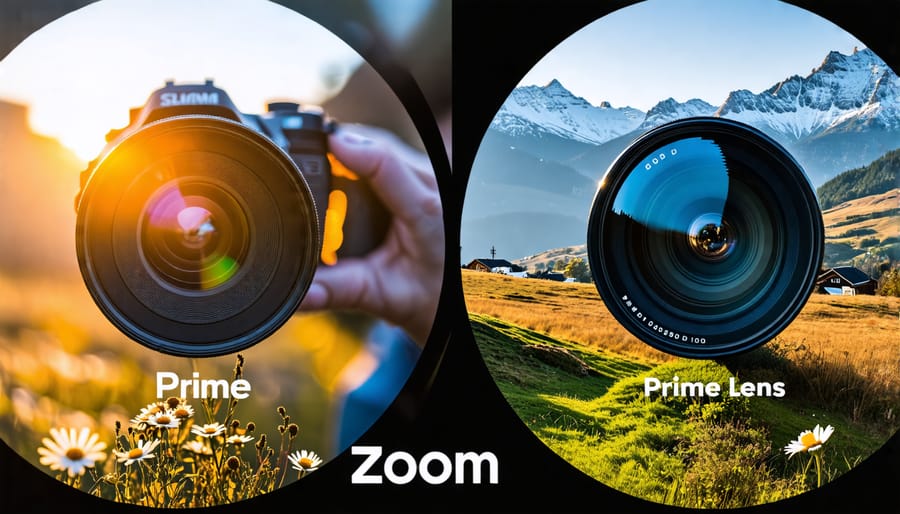
Understand how prime and zoom lenses differ in focal length flexibility. Prime lenses have a fixed focal length, offering a single field of view. Zoom lenses cover a range of focal lengths, allowing you to change perspective without swapping lenses. Learn more about how focal length impacts your photography.
Consider the impact on aperture and low light performance. Prime lenses often have wider maximum apertures, letting in more light for better performance in dim conditions and shallower depth of field. Zooms typically have smaller maximum apertures that change at different focal lengths.
Evaluate size, weight and portability differences. Prime lenses are usually more compact and lightweight than zooms covering the same focal length, making them easier to carry. However, a single zoom can replace multiple primes, saving space in your kit.
Think about how the optical designs affect image quality. With fewer moving parts and optimized optics, prime lenses tend to produce sharper images with less distortion and aberration than zooms. But high-end zooms rival the performance of primes in many cases. Read our lens sharpness guide to learn more.
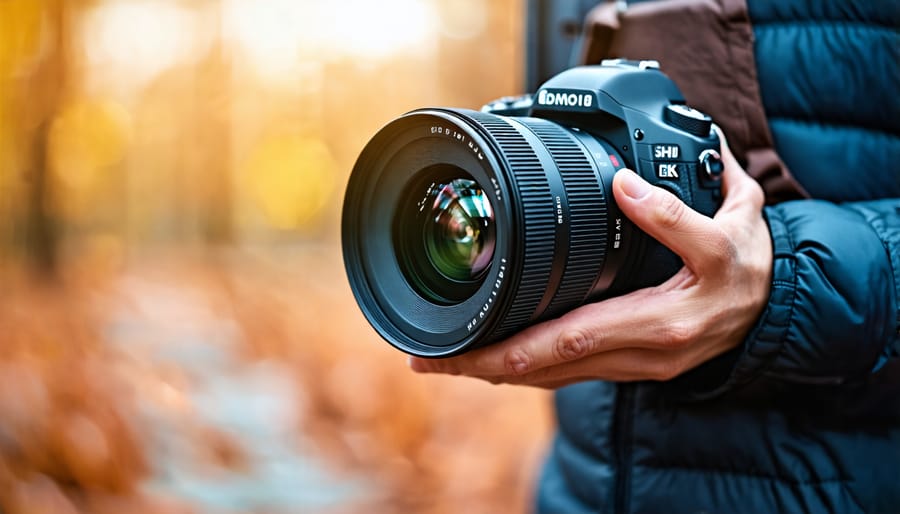
What are Prime Lenses?
Advantages of Prime Lenses
Prime lenses offer several compelling advantages for photographers. One of the most significant benefits is their wide maximum apertures, often ranging from f/1.2 to f/2.8. These wide apertures allow for excellent low light performance, enabling photographers to shoot in dimly lit environments without the need for a flash or high ISOs that can introduce noise. The wide apertures also provide a shallow depth of field, making primes ideal for portrait photography and artistic shots with beautifully blurred backgrounds.
Another advantage of prime lenses is their exceptional sharpness. Because they are designed to excel at a single focal length, prime lenses often deliver superior optical quality compared to zoom lenses. This sharpness is particularly noticeable when shooting wide open or at the edges of the frame. Additionally, prime lenses tend to be more compact and lightweight than their zoom counterparts, making them easier to carry around for extended periods. This portability is especially beneficial for street and travel photography, where every ounce counts.
While prime lenses lack the flexibility of zooms, their specialized design and performance make them an essential tool for photographers seeking the highest image quality and creative control in their work.
Drawbacks of Prime Lenses
While prime lenses offer superior image quality and low-light performance, they come with some drawbacks. The main limitation is their fixed focal length, which means you’ll need to physically move closer or further from your subject to adjust the composition. This can be inconvenient in fast-paced shooting situations where you don’t have time to change lenses. Prime lenses also offer less flexibility compared to zoom lenses, as you’re limited to a single focal length. If you frequently shoot in scenarios that require various focal lengths, you’ll need to carry multiple prime lenses, which can be cumbersome and expensive. However, for photographers who prioritize image quality and don’t mind working within the constraints of a fixed focal length, prime lenses are an excellent choice.
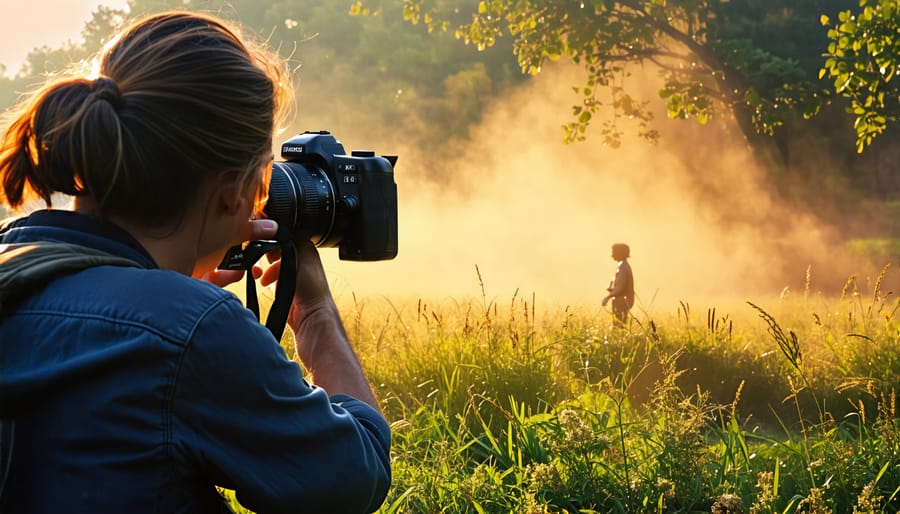
Understanding Zoom Lenses
Benefits of Zoom Lenses
One of the primary advantages of zoom lenses is their versatility. With a single lens, you can cover a wide range of focal lengths, from wide-angle to telephoto, making them ideal for situations where you need to quickly adapt to different subjects or distances. This convenience is particularly valuable for event photography, travel, or any scenario where you have limited time or space to change lenses.
Zoom lenses also allow you to adjust your composition without physically moving your position. This is especially useful when you’re shooting from a fixed vantage point, such as a designated press area or a crowded location. By zooming in or out, you can fine-tune your framing and perspective without disrupting the scene or drawing attention to yourself. Additionally, using a lens hood can help minimize lens flare and improve contrast when shooting in bright conditions.
Another benefit of zoom lenses is their ability to compress or expand the perceived distance between objects in your frame. By zooming in, you can create a more compressed perspective, making distant objects appear closer together. Conversely, zooming out can emphasize the space between objects, which is useful for creating a sense of depth or scale in your images.
Zoom Lens Compromises
While zoom lenses offer versatility, they come with some compromises compared to prime lenses. One of the main trade-offs is the maximum aperture. Zoom lenses typically have a smaller maximum aperture (higher f-number) than prime lenses, which means less light-gathering capability and shallower depth of field. Additionally, zoom lenses are often larger and heavier than prime lenses due to their more complex design and multiple moving elements. In some cases, particularly with cheaper zoom lenses, image sharpness may also be slightly compromised compared to high-quality prime lenses. However, many modern professional-grade zoom lenses offer excellent sharpness throughout their focal range.
Choosing Between Prime and Zoom Lenses
Best Uses for Prime Lenses
Prime lenses excel in several photography genres. For portrait photography, primes with wide apertures like f/1.4 or f/1.8 create stunning bokeh and subject separation, making your subject pop. In low light situations such as weddings or events, fast primes allow you to shoot at lower ISOs, resulting in cleaner images with less noise. When traveling, a lightweight prime lens kit covers multiple focal lengths without weighing you down. Primes also deliver uncompromising sharpness, clarity, and color rendition when ultimate image quality is paramount, such as in fine art or landscape photography. While less versatile than zooms, primes encourage creative problem-solving and can help take your photography to the next level in the right scenarios.
Ideal Scenarios for Zoom Lenses
Zoom lenses are ideal for situations where you need flexibility in your focal length. For events like weddings or concerts, a zoom lens allows you to quickly adjust from wide shots of the venue to tight close-ups of the subjects without having to change lenses. When shooting sports or wildlife, a telephoto zoom lens is essential for capturing distant action while maintaining sharpness and clarity. Zoom lenses also shine in scenarios where you have limited mobility or time to compose your shot, such as street photography or travel photography. The ability to zoom in and out without physically moving can be a significant advantage. However, it’s important to consider the trade-offs in aperture and overall image quality when compared to prime lenses. Ultimately, the decision between a zoom or prime lens depends on your specific needs and priorities as a photographer.
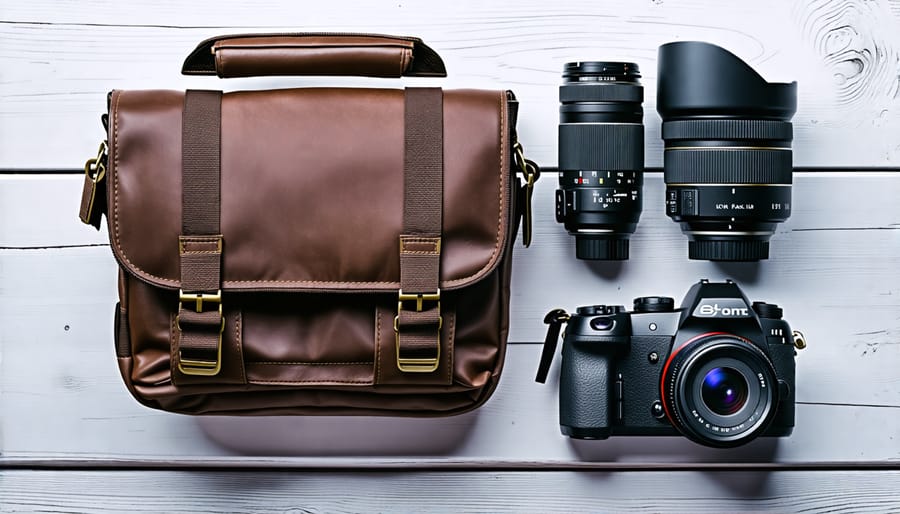
Building a Lens Kit
Building a versatile lens kit involves combining both prime and zoom lenses to cover various focal lengths and shooting scenarios. Start with a standard zoom like a 24-70mm, which is great for everyday photography. Complement it with a Best Lenses for your Canon Camera or Top Sony Lenses like a 35mm or 50mm prime for low-light situations and shallow depth of field. Add a telephoto zoom such as a 70-200mm for sports, wildlife, and portraits. Wide-angle primes like a 14mm or 24mm are ideal for landscapes and architecture. When choosing between G Lens vs G Master, consider your budget and specific needs. By having a mix of primes and zooms, you’ll be prepared for any photographic opportunity that comes your way.
Conclusion
In conclusion, the choice between prime and zoom lenses ultimately comes down to your individual photography needs and preferences. Prime lenses excel in low light, offer superior sharpness and bokeh, and encourage creative composition. However, zoom lenses provide versatility, convenience, and the ability to quickly adapt to different shooting situations without changing lenses. There is no universally perfect choice – it depends on factors such as your shooting style, subject matter, budget, and portability requirements. Many photographers find that having both types of lenses in their kit allows them to tackle a wide range of scenarios effectively. By understanding the strengths and limitations of each lens type, you can make an informed decision that will help you capture the images you envision.


